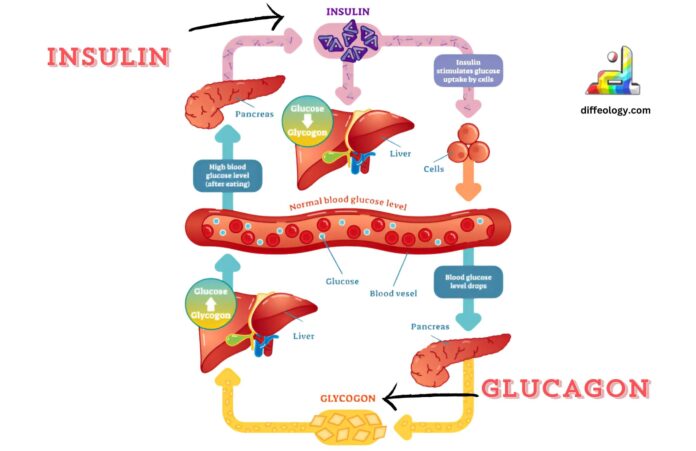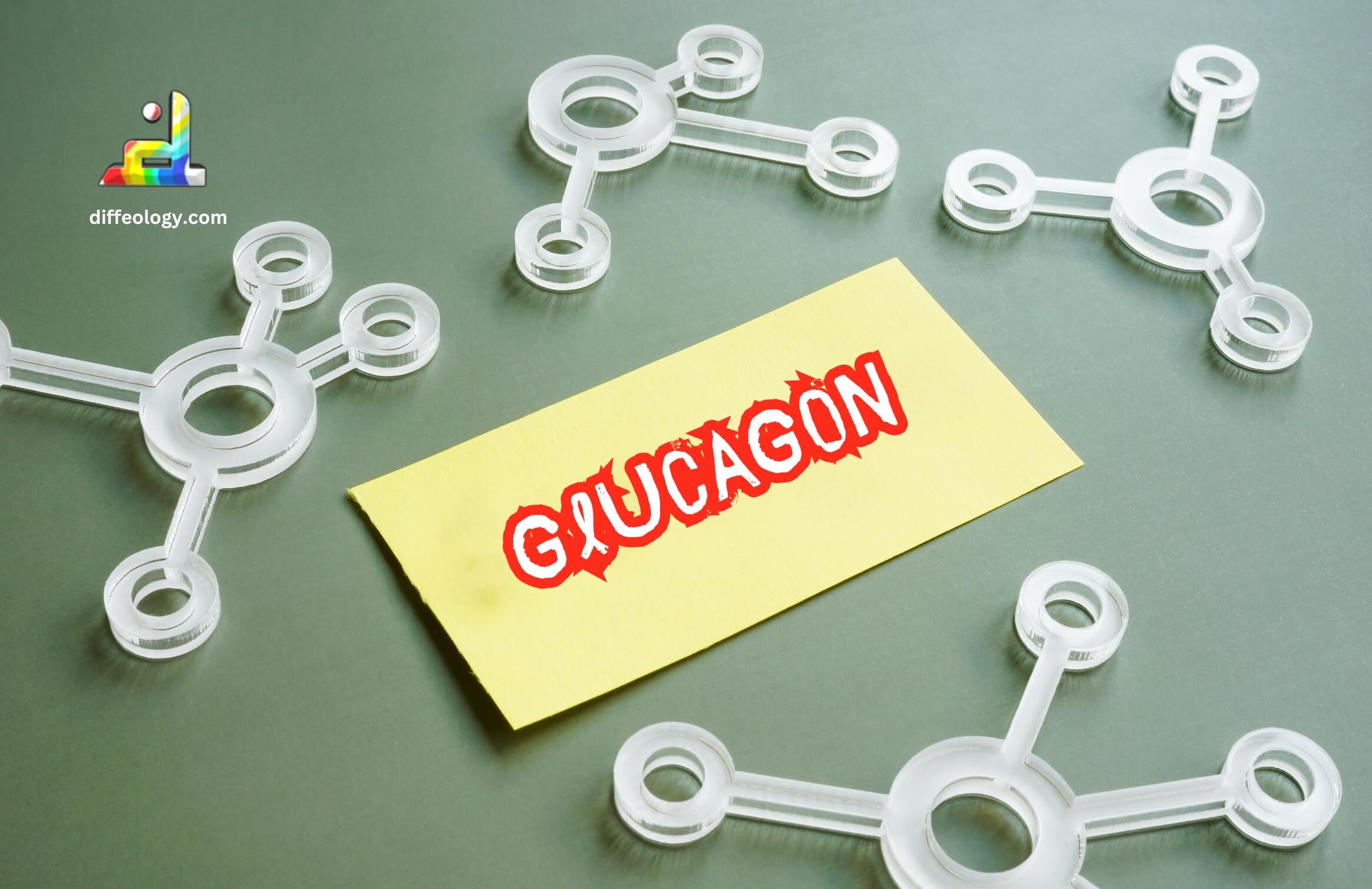Insulin and glucagon are both hormones that regulate blood sugar levels but have opposite effects. There is a huge Difference Between Insulin and Glucagon. Insulin lowers blood sugar by facilitating glucose uptake into cells and promoting glycogen formation in the liver. Glucagon raises blood sugar by stimulating glucose release from the liver and promoting glycogen breakdown. Insulin is released when blood sugar is high, whereas glucagon is released when blood sugar is low.
Main Difference Between Insulin and Glucagon
Insulin is produced by beta cells, while glucagon is produced by alpha cells, both located in the pancreas. Insulin helps lower blood sugar levels by facilitating the uptake of glucose into cells. Glucagon raises blood sugar levels by stimulating the liver to release stored glucose. Insulin decreases blood sugar levels when they are too high. Glucagon increases blood sugar levels when they are too low. After eating, insulin is released to manage the influx of glucose from food. Glucagon is not active immediately after eating.
Insulin vs. Glucagon
What is Insulin?
Insulin is a vital hormone produced by the pancreas, specifically by cells known as beta cells. It plays a crucial role in helping your body use glucose, a type of sugar, as energy. When you eat, your body breaks down food into glucose, which enters your bloodstream. Insulin acts like a key that opens up cells, allowing glucose to enter and be used for energy. Without enough insulin, or if your body doesn’t respond to it properly, glucose stays in your blood, leading to high blood sugar levels, a condition known as diabetes. For example, in Type 1 diabetes, the pancreas stops making insulin altogether, while in Type 2 diabetes, the body either doesn’t produce enough insulin or becomes resistant to it.
Read Also: Difference Between Dextrose and Glucose
Insulin is made up of 51 amino acids arranged in two chains, known as the A chain and B chain, linked together by bonds. It was first discovered in 1921, and since then, it has saved countless lives by helping manage diabetes. People with diabetes often need to take insulin as a medication to control their blood sugar levels. Insulin can be administered through injections or an insulin pump, and the dosage depends on factors like diet, exercise, and the severity of the condition. Managing insulin levels is critical because too much or too little insulin can cause severe health problems, including hypoglycemia (low blood sugar) or hyperglycemia (high blood sugar).
What is Glucagon?
Glucagon is a hormone produced by the pancreas, specifically by cells called alpha cells. Its primary role is to regulate blood sugar levels by raising them when they drop too low, a condition known as hypoglycemia. When your blood sugar drops, glucagon signals the liver to release stored glucose, also called glycogen, into the bloodstream, this process ensures that your body has enough energy to function properly, especially during periods when you haven’t eaten for a while. Without glucagon, your body would struggle to maintain stable blood sugar levels, which could lead to serious health problems.
Read Also: Difference Between Vitamin D and D3
Glucagon works in tandem with insulin, another hormone produced by the pancreas. While insulin lowers blood sugar by helping cells absorb glucose, glucagon does the opposite by increasing blood sugar levels when they’re too low. This balance between insulin and glucagon is crucial for keeping your body’s energy levels stable. In people with diabetes, this balance can be disrupted, leading to either high or low blood sugar. In cases of severe hypoglycemia, glucagon injections can be used as an emergency treatment to quickly raise blood sugar levels.
Comparison Table “Insulin Vs. Glucagon”
| Source | Secreted by beta cells in the pancreas | Secreted by alpha cells in the pancreas |
| Function | Lowers blood sugar levels | Raises blood sugar levels |
| Effect on Cells | Promotes glucose uptake into cells | Stimulates the release of glucose from the liver |
| Release Trigger | Increased blood glucose levels | Decreased blood glucose levels |
| Action Location | Mainly in muscles and fat | Mainly in the liver |
| Impact on Liver | Decreases glucose production | Increases glucose production |
| Disease Link | High levels associated with diabetes | Low levels can cause hypoglycemia |
| Form | Peptide hormone | Peptide hormone |
| Interaction | Works with glucagon to maintain balance | Works with insulin to maintain balance |
| Effects on Glycogen | Promotes glycogen formation | Promotes glycogen breakdown |
| Administration | Can be administered externally in diabetes | Rarely administered but used in severe hypoglycemia |
| Time of Action | Acts quickly to lower blood sugar | Acts quickly to raise blood sugar |
| Primary Role | Reduces hyperglycemia | Prevents hypoglycemia |
| Feedback Mechanism | Part of a feedback loop for blood glucose | Part of a feedback loop for blood glucose |
| Regulation | Regulated by blood glucose levels | Regulated by blood glucose levels |
| Balance | Balances high blood sugar | Balances low blood sugar |
Difference Between Insulin and Glucagon in Detail
Get to know the Difference Between Insulin vs. Glucagon in Detail
-
Hormone Production: Origins and Functions
Insulin and glucagon are hormones produced by the pancreas, but they have different functions in the body. Insulin is produced by beta cells in the islets of Langerhans, and its primary role is to lower blood glucose levels by facilitating the uptake of glucose into cells. When you eat, your blood sugar levels rise, and insulin is released to help transport glucose into cells for energy or storage as glycogen in the liver and muscles.
Glucagon, on the other hand, is produced by alpha cells in the pancreas. Its role is essentially the opposite of that of insulin. When blood sugar levels drop, such as between meals or during physical activity, glucagon is released to signal the liver to convert stored glycogen back into glucose and release it into the bloodstream. This process helps maintain a stable blood sugar level, ensuring that your body has a steady energy supply.
-
Role in Blood Sugar Regulation
Both insulin and glucagon play crucial roles in maintaining blood sugar levels within a narrow range, but they work in opposite ways. Insulin helps lower blood glucose levels by promoting the absorption of glucose into the liver, fat, and muscle cells. When blood sugar levels are too high, such as after eating a meal, insulin is released to bring those levels down.
In contrast, glucagon works to raise blood glucose levels. When the body needs more glucose, like during fasting or intense exercise, glucagon signals the liver to release glucose stored as glycogen. This increase in glucose ensures that the body has enough energy to function, particularly when food intake is low.
-
Impact on Energy Storage and Utilization
Insulin promotes energy storage in the body by encouraging the conversion of glucose into glycogen, which is stored in the liver and muscles. If these stores are full, insulin also promotes the storage of excess glucose as fat. This energy storage ensures that the body has reserves to draw upon when needed, such as between meals or during prolonged physical activity.
Glucagon, in contrast, helps the body utilize stored energy. When glucose levels are low, glucagon signals the liver to break down glycogen back into glucose, which is then released into the bloodstream. This process provides a quick source of energy, particularly important during times when the body is not receiving glucose from food.
-
Influence on Metabolic Processes
Insulin is an anabolic hormone, meaning it promotes the building up of complex molecules like glycogen and fat from simpler ones like glucose. This anabolic effect helps with cell growth, muscle building, and overall energy storage. Insulin also affects protein metabolism by promoting the uptake of amino acids into cells, which helps in protein synthesis.
Glucagon, however, is a catabolic hormone, meaning it breaks down complex molecules into simpler ones to release energy. For example, glucagon stimulates the breakdown of glycogen into glucose in the liver. It also promotes the breakdown of fats into fatty acids, which can be used by the body for energy, particularly during fasting or prolonged exercise.
-
Response to Dietary Intake
Insulin levels rise after eating, especially when consuming carbohydrates, as these foods cause blood glucose levels to increase. The body responds by releasing insulin to help cells absorb glucose and use it for energy or store it for later use. This process prevents hyperglycemia, which is an excessively high level of glucose in the blood.
Glucagon, on the other hand, is more active during periods of fasting or when the diet is low in carbohydrates. When blood glucose levels fall, glucagon is released to trigger the conversion of glycogen to glucose in the liver, ensuring that the body maintains an adequate supply of energy even when food intake is low.
-
Relation to Diabetes and Other Disorders
Insulin and glucagon have critical roles in disorders like diabetes. In type 1 diabetes, the body cannot produce enough insulin, leading to high blood sugar levels that can be dangerous if not managed. Type 2 diabetes, the more common form, involves the body becoming resistant to insulin, which also results in high blood glucose levels.
Glucagon’s role in diabetes is less direct but still important. In diabetes, the regulation of glucagon can be impaired, leading to inappropriate glucose release from the liver. This can contribute to the high blood sugar levels seen in people with diabetes, particularly during fasting or overnight.
-
Medical Uses and Treatments
Insulin therapy is a common treatment for people with diabetes, particularly those with type 1 diabetes, where the body cannot produce insulin. Synthetic insulin is administered to help manage blood glucose levels. Insulin pumps, injections, and inhalers are some methods used to deliver insulin to the body, ensuring that glucose levels are kept within a healthy range.
Glucagon is also used medically, particularly in emergency situations, to treat severe hypoglycemia (low blood sugar). Glucagon injections can quickly raise blood glucose levels by stimulating the liver to release stored glucose. This is critical for people with diabetes who may experience dangerously low blood sugar levels due to insulin therapy or other factors.
Key Difference Between Insulin and Glucagon
- Response to Fasting: During fasting, insulin secretion decreases to prevent blood sugar from dropping too low. Glucagon is secreted to maintain blood sugar levels by releasing glucose from the liver.
- Target Organs: Insulin primarily targets muscle, fat, and liver cells. Glucagon primarily targets the liver.
- Storage Role: Insulin promotes the storage of glucose in the liver and muscles as glycogen. Glucagon breaks down glycogen back into glucose for energy.
- Role in Diabetes: In diabetes, insulin production or function is impaired, leading to high blood sugar. Glucagon levels may become imbalanced, worsening blood sugar control.
- Release Triggers: Insulin is released in response to high blood sugar. Glucagon is released in response to low blood sugar.
- Hormonal Interaction: Insulin and glucagon have opposite effects but work together to maintain balanced blood sugar levels.
- Metabolic Effects: Insulin promotes the use of glucose for energy and fat storage. Glucagon promotes the breakdown of stored fats for energy.
- Protein Synthesis: Insulin helps in protein synthesis by allowing cells to take in amino acids. Glucagon doesn’t directly affect protein synthesis.
- Influence on Appetite: Insulin can decrease appetite by signaling satiety. Glucagon may increase appetite when blood sugar is low.
- Effect on Fat Storage: Insulin promotes fat storage by converting excess glucose into fat. Glucagon helps break down fat to release energy.
- Role in Stress: During stress, glucagon levels increase to ensure sufficient glucose is available. Insulin levels may drop to prevent hypoglycemia during stress.
- Clinical Use: Insulin is used to treat diabetes by lowering blood sugar. Glucagon can be administered during severe hypoglycemia to raise blood sugar.
- Effect on the Liver: Insulin promotes glycogen storage in the liver. Glucagon triggers the liver to release glucose into the blood.
FAQs: Insulin vs. Glucagon
Conclusion:
Difference Between Insulin and Glucagon is obvious. Insulin and glucagon are two pivotal hormones that regulate blood glucose levels, each with distinct roles and mechanisms. Insulin, produced by the beta cells of the pancreas, is primarily responsible for lowering blood glucose by facilitating its uptake into cells and promoting its storage as glycogen in the liver and muscles. This hormone plays a critical role in managing the body’s energy reserves and ensuring that cells receive the glucose they need for metabolic functions. Conversely, glucagon, secreted by the alpha cells of the pancreas, works to elevate blood glucose levels by stimulating glycogen breakdown in the liver and encouraging gluconeogenesis. This ensures a steady supply of glucose, particularly during fasting or periods of intense physical activity.



